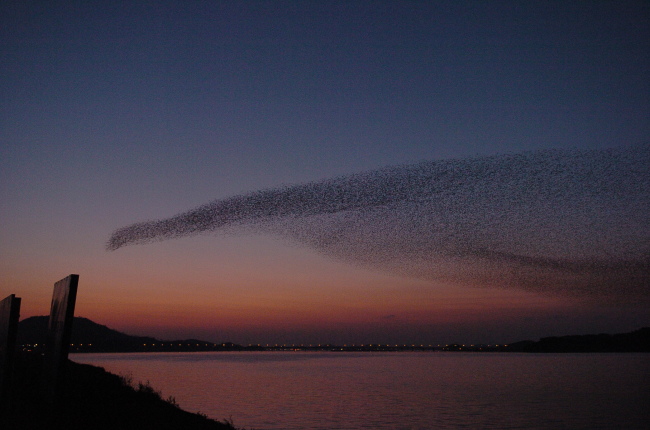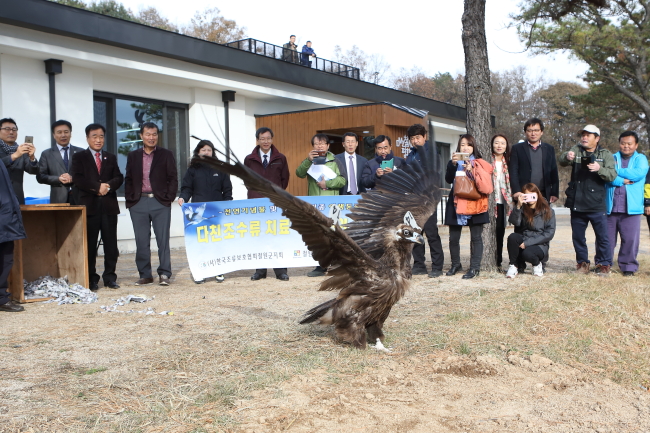CHEORWON, Gangwon Province -- From October, hundreds of winged guests arrive at Cheorwon, a rural town near the northern border.
On a long, arduous journey to southern wintering grounds, about 800 cranes make a stopover at Cheorwon for its some 10,500 hectares of rice fields, which provide abundant food and resting places for them.
Kim Su-ho, a local vet for wild birds with over 20 years of experience, says he is able to tell the difference between cranes that have been there before and those visiting for the first time.
“I recognize the cranes. This year, one of the red-crowned crane families brought a new female bird. I’m thinking maybe I will get to see a new baby bird next year,” Kim told The Korea Herald.
 |
(Geumgang Migratory Bird Observatory) |
Cheorwon is probably the only place on Earth where one can witness the stopover of white-naped cranes and red-crowned cranes every year, he went on, adding that out of 15 surviving species of cranes, seven visit here seasonally.
“What is most important is to allow these precious guests to rest well, while they are here,” said Kim, who is also the chief director of the Korean Association for Birds Protection in Cheorwon.
According to the International Union for Conservation of Nature, half of the world’s crane species including hooded cranes and red-crowned cranes are endangered species.
Migratory birds travel thousands of kilometers and they often face hardship during the long, arduous journey. On their way to wintering grounds in warmer parts of the world, they encounter countless dangers including collisions, pollution, poaching and poisoning.
 |
An eagle is released and tries to fly after his wounded leg is treated at the DMZ Peace Town for Migratory Birds in Cheorwon, Gangwon Province. At least 200 migratory birds are released after treatment in Cheorwon each year. (Cheorwon County) |
South Korea, part of the world’s greatest international migration route -- the avian East Asian Australasian Flyway, offers a sanctuary for some of these birds.
Some 50 million birds -- from cranes to song birds -- fly to Korea during their seasonal migration.
Some arrive as early as in October and stay until February. Last year, some 20 million migratory birds, including some 800 cranes, flew here.
Magnificent sights of vultures, red-crowned cranes and white-tailed sea eagles taking off en masse draw hundreds of bird-watchers to Cheorwon and other major migratory bird sanctuaries every winter.
While humans have only been able to track down just three major flyways across Asia so far, the routes followed by migratory birds on their journeys have been passed down from generation to generation among birds, ecology experts said.
“It is instinct for birds to fly in flocks toward feeding and resting sites,” said Kim Kyung-won, a bird expert and environmental campaigner at the World Wildlife Fund in Seoul.
“Imagine if the birds one day have to find a new place to land during winter, because their habitats and stopover sites have been destroyed. That would not only lead them to lose their way. It could lead to their extinction,” Kim said.
He highlighted that mudflats in some major wild life sanctuaries have already been converted to dry land for agriculture and industrial development.
“The expansive mudflats are normally rich in marine worms and crustaceans, which many shorebirds depend on for food.”
According to ecology expert Richard Fuller, only one third of Asia’s mudflat habitat remains compared to 50 years ago.
In the past few decades, more than 40 percent of migratory birds have disappeared and over 200 species are now classified as endangered species globally.
With the aim of preserving Cheorwon as a habitat for migratory birds, Cheorwon County recently opened the DMZ Peace Town for Migratory Birds, a center for studying migratory birds and campaigning about habitat preservation, as part of a joint effort with the World Wide Fund For Nature Korea.
Located in an old elementary school building, the center is equipped with a library, a cafe and lodging for visitors. Cheorwon County said it is planning a variety of programs for visitors such as excursions to wetlands or crane habitats.
“Ecological preservation does not start … from cooperating with residents here to (help them) view migratory birds with welcoming hearts and continue to provide the birds with good food sources,” said Lee Hyun-jong, the governor of Cheorwon County.
“By working closely with WWF, we support more birdwatchers to come and observe birds in a better setting, so they will know Cheorwon as a paradise for migratory birds,” added Lee.
 |
Residents and officials throw food for migratory birds at a field, as part of a program hosted at the DMZ Peace Town for Migratory Birds in Cheorwon, Gangwon Province. (Cheorwon County) |
However, conservationists say what should come before the promotion of bird-watching is understanding the seasonal movement of these birds.
“The study of migrant birds shouldn’t stop at solving the mysteries of their migration and habits. It should lead to a change in people’s perception and attitude toward wildlife and the winter birds visiting here once a year,” said Kim from WWF.
The bird vet Kim, and fellow members of the association of bird protectors in Cheorwon, are committed to providing the best care for cranes while they are here.
“We find at least 200-300 migratory birds each year on roads with broken wings or legs, wounded eyes and more,” said Kim Kyung-ja, a member of the Korean Association for Birds Protection.
“Those birds visiting here once a year do not belong to us. They belong to the Earth. Birds can fly anywhere and everywhere. They should fly safely back home, so they can return next time,” she said.
By Kim Da-sol / (
ddd@heraldcorp.com)









![[Today’s K-pop] Blackpink’s Jennie, Lisa invited to Coachella as solo acts](http://res.heraldm.com/phpwas/restmb_idxmake.php?idx=644&simg=/content/image/2024/11/21/20241121050099_0.jpg)
